Enhance Oil Recovery in Fracture-Cave Carbonate Reservoirs Using Zwitterion-Anionic Composite Surfactant System
Abstract
1. Introduction
2. Construction of Surfactant System
2.1. Materials and Constructed Mechanism
2.1.1. Materials
2.1.2. Constructed Mechanism
2.2. Surfactant Optimization
2.2.1. Anionic Surfactant Optimization
2.2.2. Zwitterionic Surfactant Optimization
2.3. Optimal Surfactant System
3. Performance Evaluation
3.1. Wettability Evaluation
3.1.1. Experiment
3.1.2. Result Analysis
3.2. Evaluation of Oil Film Stripping Performance
3.2.1. Experiment
3.2.2. Result Analysis
3.3. Emulsification Performance Evaluation
3.3.1. Experiment
3.3.2. Result Analysis
3.4. Oil Displacement Experiment
3.4.1. Experiment
3.4.2. Result Analysis
4. Conclusions
Author Contributions
Funding
Data Availability Statement
Conflicts of Interest
References
- Zhang, Y.; Yan, H.; Wei, Y.; Cao, Z.; Gao, J.; Yang, S.; Deng, H.; Chen, Z.; Zheng, G.; Wang, Z. Effect of pore throat structure on flow capacity of multi-type ultra-deep carbonate gas reservoirs. J. China Univ. Pet. (Ed. Nat. Sci.) 2024, 48, 131–140. [Google Scholar] [CrossRef]
- Wang, M.; Li, Y.; Wu, K.; Chen, Z.; Li, J.; Feng, D.; Zhu, Q.; Guo, S. Quantitative characterization of microscopic pore structure and oil recovery evaluation in porous carbonate reservoirs. Pet. Geol. Recovery Effic. 2024, 31, 96–107. [Google Scholar] [CrossRef]
- Yang, D.; Lu, X.; Bao, D.; Cao, F.; Wang, Y.; Wang, M.; Xie, R. New insights into the genetic types and characteristics of the Ordovician marine fault-karst carbonate reservoirs in the northern Tarim Basin. Oil Gas Geol. 2024, 45, 357–366. [Google Scholar] [CrossRef]
- Habib, S.H.; Yunus, R.; Zakaria, R.; Biak, D.R.A.; Jan, B.H.M.; Amir, M. Chemical enhanced oil recovery: Synergetic mechanism of alkali, surfactant and polymer with overview of methyl ester sulfonate as a green alternative for EOR surfactant. Fuel 2024, 363, 130957. [Google Scholar] [CrossRef]
- Yuan, C.; Pu, W.; Varfolomeev, M.A.; Tan, T.; Timofeeva, A.A.; Sitnov, S.A.; Mustafin, A.Z. Salt-Tolerant Surfactant for Dilute Surfactant Flooding in High-Salinity Reservoirs: Residual Oil Stripping and Displacement Mechanism and Efficiency by Ultra-Low Interfacial Tension. In Proceedings of the SPE Conference: Abu Dhabi International Petroleum Exhibition & Conference, Abu Dhabi, United Arab Emirates, 9–12 November 2020; SPE Publishing: Richardson, TX, USA, 2020. [Google Scholar] [CrossRef]
- Somoza, A.; Rodríguez-Cabo, B.; Barrio, I.; García-Mayoral, M.F.; Soto, A. Experimental Evaluation of Blends Containing Lineal Alkylbenzene Sulfonates for Surfactant Flooding in Carbonate Reservoirs. SPE Res. Eval. Eng. 2023, 26, 1309–1322. [Google Scholar] [CrossRef]
- Li, X.; Yue, X.; Zou, J.; Zhang, L.; Kang, T. The Role of Emulsification and Interfacial Tension Ift For the Enhanced Oil Recovery Eor in Surfactant Flooding. In Proceedings of the SPE Conference: Russian Petroleum Technology Conference, Virtual, 12–15 October 2021; SPE Publishing: Richardson, TX, USA, 2021. [Google Scholar] [CrossRef]
- Adel, I.A.; Hassan, A.M.; Al-Shalabi, E.W.; Emad, W.; AlAmeri, W. A Look Ahead to the Future of Surfactant Flooding EOR in Carbonate Reservoirs under Harsh Conditions of High Temperature and High Salinity. In Proceedings of the SPE Conference: Gas & Oil Technology Showcase and Conference, Dubai, United Arab Emirates, 13–15 March 2023; SPE Publishing: Richardson, TX, USA, 2023. [Google Scholar] [CrossRef]
- Hassan, M.; Channa, S.H.; Qazi, S.E.; Ali, S.; Sandeep, K. Design and Analysis of Laboratory Experiment on Surfactant-Flooding with Software Protocol. In Proceedings of the SPE Conference: SPE/PAPG Pakistan Section Annual Technical Conference, Islamabad, Pakistan, 24–25 November 2015; SPE Publishing: Richardson, TX, USA, 2015. [Google Scholar] [CrossRef]
- Zhang, Y.; Qi, J.; Wang, N.; Wang, L.; Lu, H.S. Pseudo gemini surfactant fracturing fluid with dual function of fracturing and oil flooding for enhanced oil recovery. J. Mol. Liq. 2024, 393, 123562. [Google Scholar] [CrossRef]
- Massarweh, O.; Abushaikha, A.S. Application of surfactants in enhancing oil recovery from tight carbonates: Physicochemical properties and core flooding experiments. Geoenergy Sci. Eng. 2023, 221, 211400. [Google Scholar] [CrossRef]
- Zhou, B.; Kang, W.; Wang, Q.; Li, X.; He, Y.; Jia, R.; Wang, K.; Zhao, Z.; Yang, H.; Zhe, L. Enhanced oil recovery performance and mechanism of a wormlike micelles flooding system with zwitterionic-anionic surfactants. J. Mol. Liq. 2022, 362, 119726. [Google Scholar] [CrossRef]
- Lu, J.; Goudarzi, A.; Chen, P.; Kim, D.; Delshad, M.; Mohanty, K.; Sepehrnoori, K.; Weerasooriya, U.P.; Pope, G.A. Enhanced oil recovery from high-temperature, high-salinity naturally fractured carbonate reservoirs by surfactant flood. J. Pet. Sci. Eng. 2014, 124, 122–131. [Google Scholar] [CrossRef]
- Sofla, S.J.D.; Sharifi, M.; Sarapardeh, A.H. Toward mechanistic understanding of natural surfactant flooding in enhanced oil recovery processes: The role of salinity, surfactant concentration and rock type. J. Mol. Liq. 2016, 222, 632–639. [Google Scholar] [CrossRef]
- Pu, E.; Wang, X.; Zhong, C.; He, X.; Zhu, X. Modification of a hybrid fluoro-surfactant containing double fluorocarbon chains on the carbonate and shale rocks for the wettability reduction of water and oil. Geoenergy Sci. Eng. 2024, 240, 213009. [Google Scholar] [CrossRef]
- Lei, X.; Liu, B.; Hou, Q.; Wang, Y.; Ahmadi, M.; Liu, Z.; Chen, Z. Switchability and synergistic effect of a CO2-responsive surfactant with co-surfactants at an O/W interface: A molecular insight. J. Mol. Liq. 2024, 405, 125051. [Google Scholar] [CrossRef]
- Bian, S.; Liu, P.; Mao, Z.; Huang, W.; Zhu, Y.; Zhang, L.; Hou, Y.; Zhang, L. Studying the factors determining the ultralow interfacial tensions of betaine solutions against crude oil. Colloids Surf. A Physicochem. Eng. Asp. 2024, 686, 133453. [Google Scholar] [CrossRef]
- Gong, J.; Wei, M.; Li, B.; He, M.; Ye, J. Preparation and application of surfactant repellents suitable for high temperature and high salt carbonate reservoir. Chem. Res. Appl. 2023, 35, 470–476. [Google Scholar]
- Yu, X.; Wu, J.; Zhao, Y.; Hou, Y.; Li, B.; Wang, S. Performance Evaluation and oil displacement Effect of HY nanometre Surfactant. Contemp. Chem. Ind. 2023, 52, 2163–2167. [Google Scholar] [CrossRef]
- Wang, W.; Liang, M.; Lang, J.; Mtui, H.I.; Yang, S.; Mu, B. A new bio-based zwitterionic surfactant with strong interfacial activity at high temperature for enhanced oil recovery. Green Mater. 2023, 12, 50–59. [Google Scholar]
- Saifullin, E.R.; Putintseva, P.O.; Sagirov, R.N.; Varfolomeev, M.A.; Yuan, C.; Pavelyev, R.S.; Nazarychev, S.A.; Malahov, A.O.; Akimushkina, L.; Zharkov, D.A.; et al. Novel Nonylphenol Polyethoxylated Based Surfactants for Enhanced Oil Recovery for High-Mineralization Carbonate Reservoir. Energies 2022, 15, 961. [Google Scholar] [CrossRef]
- Saw, R.K.; Rane, P.M.; Joshi, D.; Prakash, S.; Jangid, L.; Mandal, A. Enhanced oil recovery using a novel non-ionic surfactant synthesized from olive oil: Performance and synergistic effects. J. Mol. Liq. 2023, 392, 123452. [Google Scholar] [CrossRef]
- Panthi, K.; Mohanty, K.K. Surfactant-polymer flood with seawater for a high temperature carbonate reservoir. Colloids Surf. A Physicochem. Eng. Asp. 2024, 688, 133615. [Google Scholar] [CrossRef]
- Hassan, A.; Al-Shalabi, E.W.; Alameri, W.; Kamal, M.; Patil, S.; Hussain, S. Manifestations of surfactant-polymer flooding for successful field applications in carbonates under harsh conditions: A comprehensive review. J. Pet. Sci. Eng. 2023, 220, 111243. [Google Scholar] [CrossRef]
- Qu, H.; Shang, Y.; Zhang, G.; Wang, H.; Wei, L.; Dai, Q. Preparation and performance evaluation of injection-boosting oil repellents for pressure drive. Oilfield Chem. 2022, 39, 039. [Google Scholar] [CrossRef]
- Lin, F.; Tan, C.; Cai, H. Application of new process of fracturing and oil drive on three types of oil reservoirs. Chem. Eng. Equipment. 2019, 1, 139–140. [Google Scholar] [CrossRef]
- Shen, H.; Ma, Y.; Wang, Y.; Niu, J.; Liu, K.; He, Y. Application of pressure-drive integration technology for water injection wells in tight sandstone reservoirs. Petrochem. Appl. 2023, 42, 76–78. [Google Scholar] [CrossRef]
- Zhang, L. Progress of enhanced recovery technology and direction of research in old oilfields of east China Petroleum & Chemical Corporation. Oil Gas Geol. 2022, 43, 717–723. [Google Scholar] [CrossRef]
- Zhang, Y.; Cheng, Y. Feasibility of digging out the remaining potential in Daqing Lamaidean Oilfield after polycondensation drive and pressure plugging drive. Daqing Pet. Geol. Dev. 2022, 41, 109–116. [Google Scholar] [CrossRef]
- Cui, C.; Wang, J.; Wu, Z.; Zhang, C.; Li, H.; Zhang, Y.; Zheng, W. Establishment and application of dynamic fracture model for pressure-driven fracturing in tight reservoirs. Spec. Reserv. 2023, 30, 87–95. [Google Scholar] [CrossRef]
- Yang, Y.; Zhang, S.; Cao, X.; Lv, Q.; Wang, J.; Liu, H.; Yu, C.; Sun, H. Practice and understanding of pressure drive development technology for low-permeability reservoirs in Shengli Oilfield. Pet. Geol. Recovery Effic. 2023, 30, 61–71. [Google Scholar] [CrossRef]
- Zhang, Y.; Yang, Y.; Sun, Z.; Yu, C.; Sun, Q. Physical simulation of pressure drive and quantitative characterization of fractures in low-permeability reservoirs. Oil Gas Geol. Recovery 2022, 29, 143–149. [Google Scholar] [CrossRef]
- Guo, J.; Ma, Z.; Lu, C. Progress and development direction of fracturing technology in tight oil reservoirs in China. J. Pet. 2022, 43, 1788–1797. [Google Scholar] [CrossRef]
- Shi, D.; Wang, H.; Hua, K. Research on ultra-low interfacial tension surfactants for oil repelling in an oil field in Bohai Sea. Oil Gas Chem. 2023, 52, 83–88. [Google Scholar] [CrossRef]
- Zhang, J.; Wang, M.; Wu, J. Synthesis and pressure-driving process of a new type of nano-percolator. Appl. Chem. Eng. 2021, 50, 1239–1244. [Google Scholar] [CrossRef]
- Wang, F.; Xu, H.; Liu, Y.; Xu, H.; Wu, C. Mechanism of high pressure drop adsorption for enhanced recovery in pressure drive technology. J. Pet. 2024, 45, 403–411. [Google Scholar] [CrossRef]
- Sun, H.; Cao, X.; Zhang, L. Interfacial Chemistry of Surfactants for Oil Repulsion in Interfacial Rheology; Science Press: Beijing, China, 2016. [Google Scholar]
- Qu, H.; Sun, Y.; Zhang, G.; Guo, H.; Wang, H.; Dai, Q.; Wu, Q. Influencing factors and quantitative analysis of emulsification of refractory milk extract. Oilfield Chem. 2024, 41, 516–521. [Google Scholar] [CrossRef]
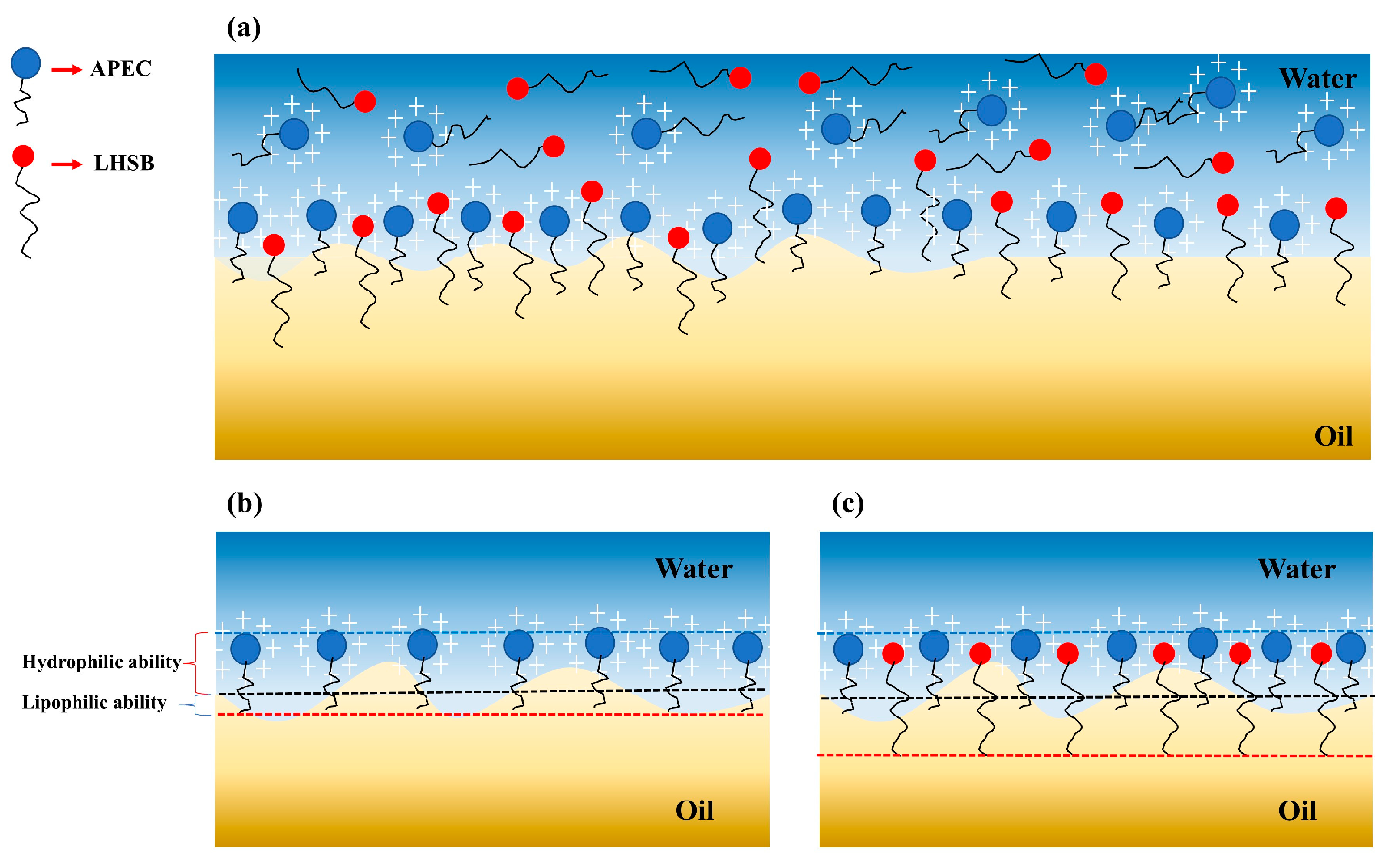
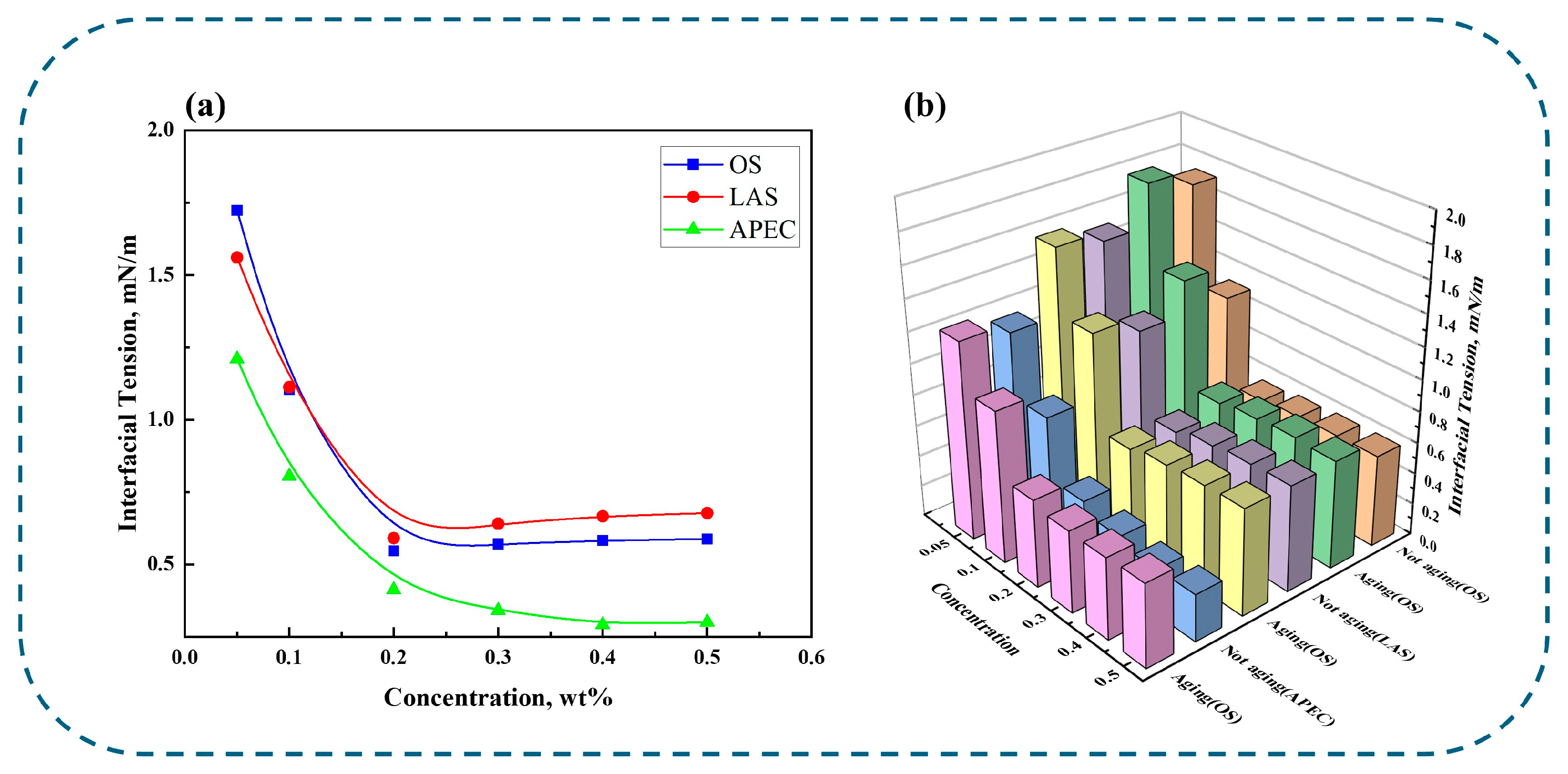
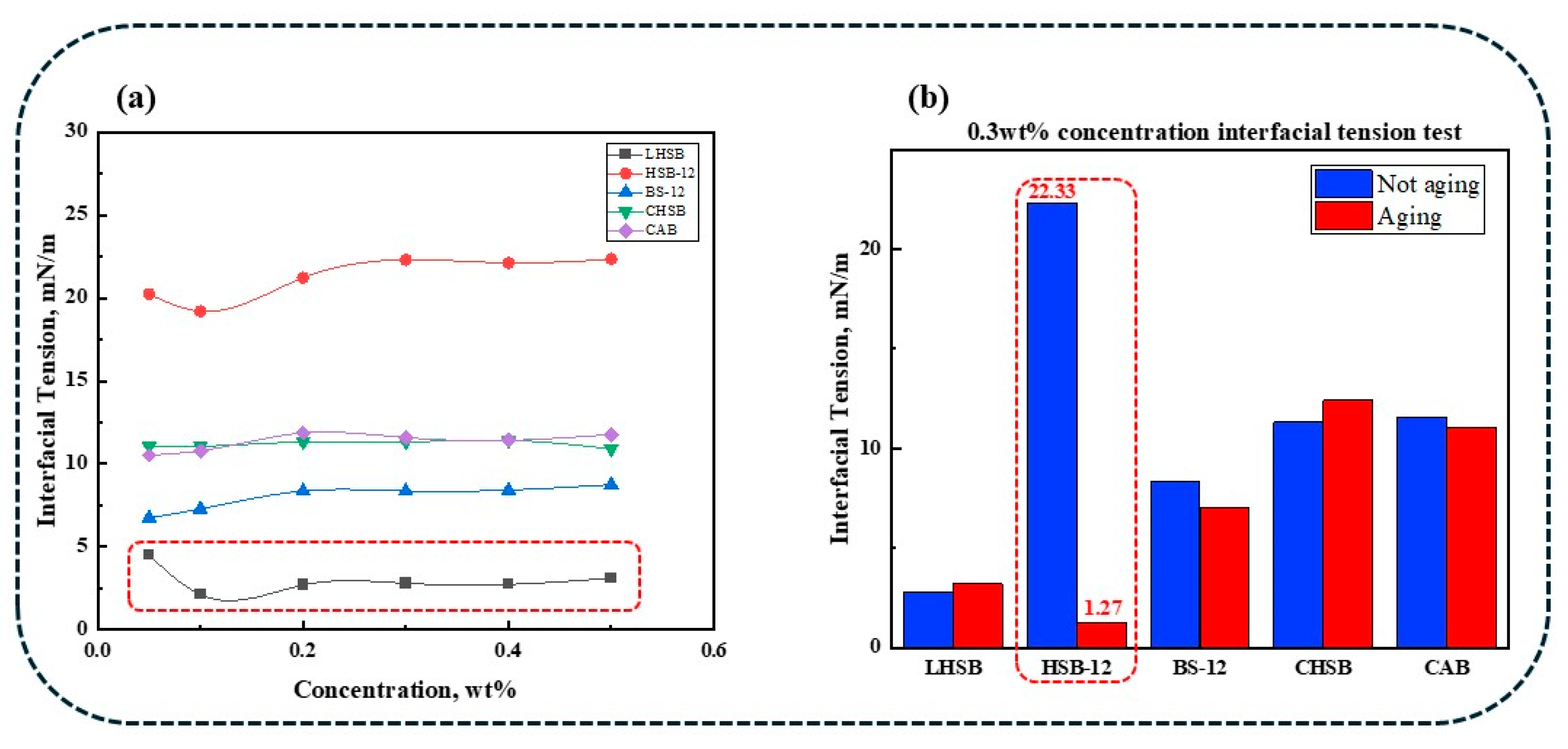
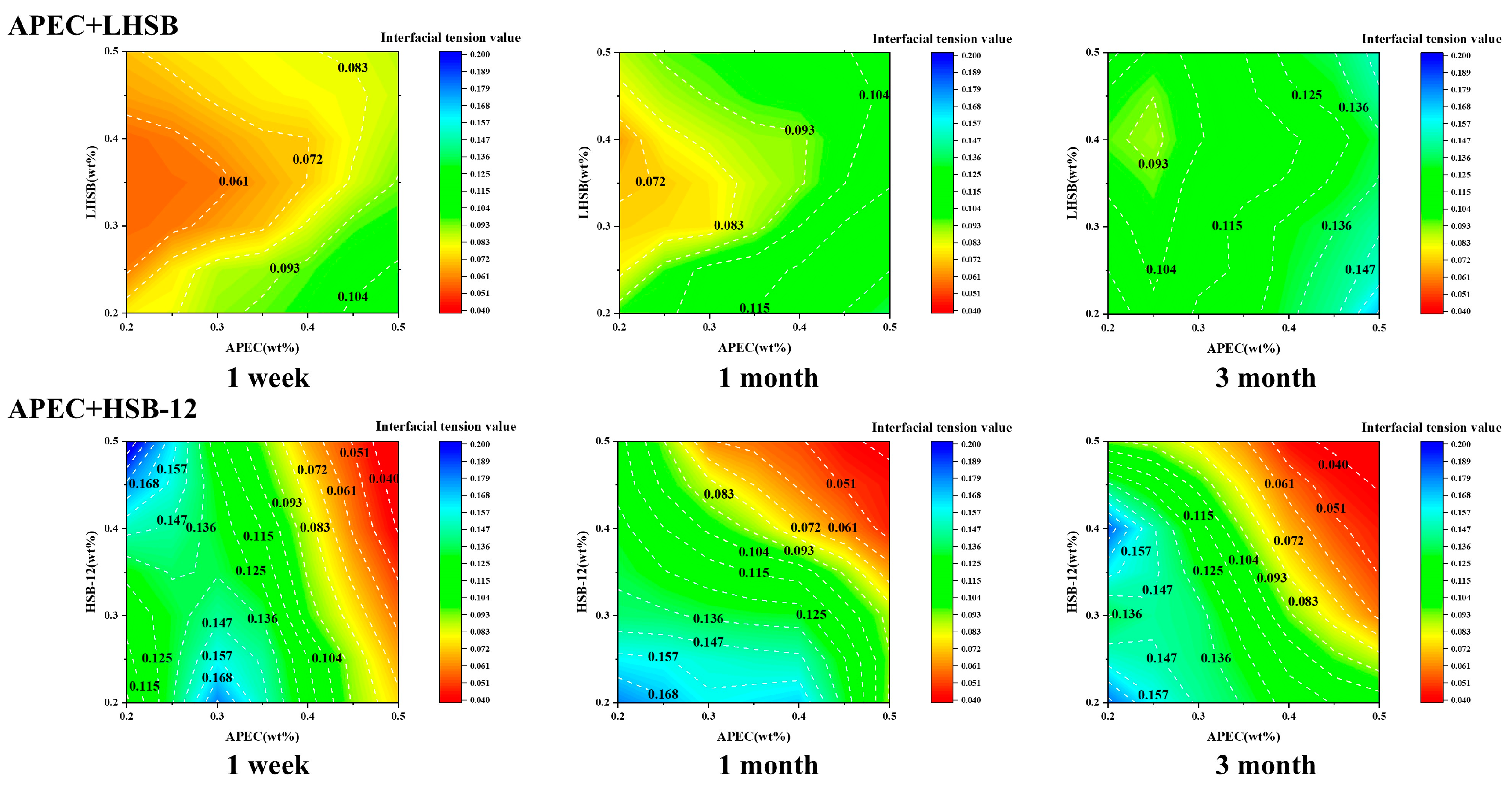
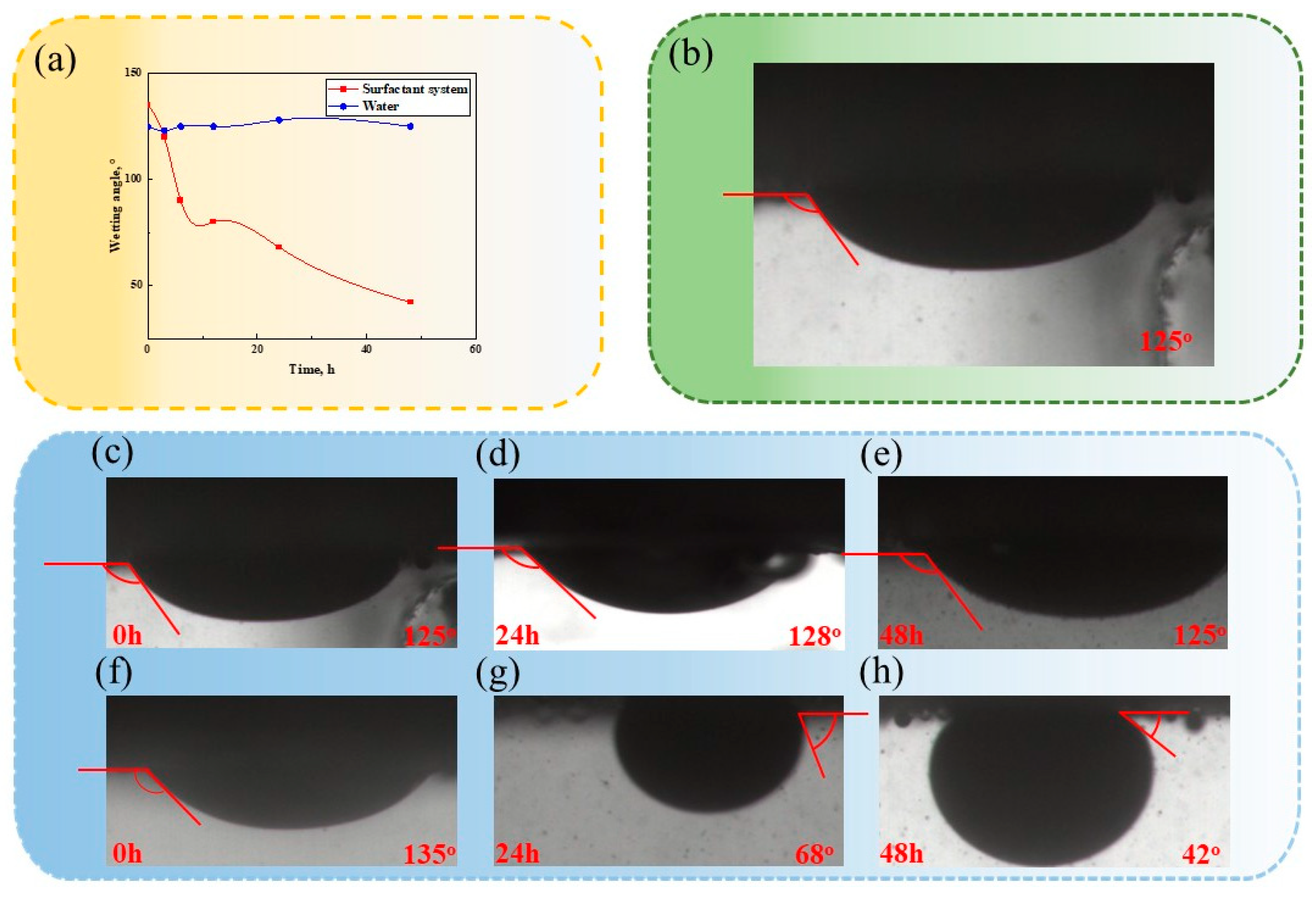
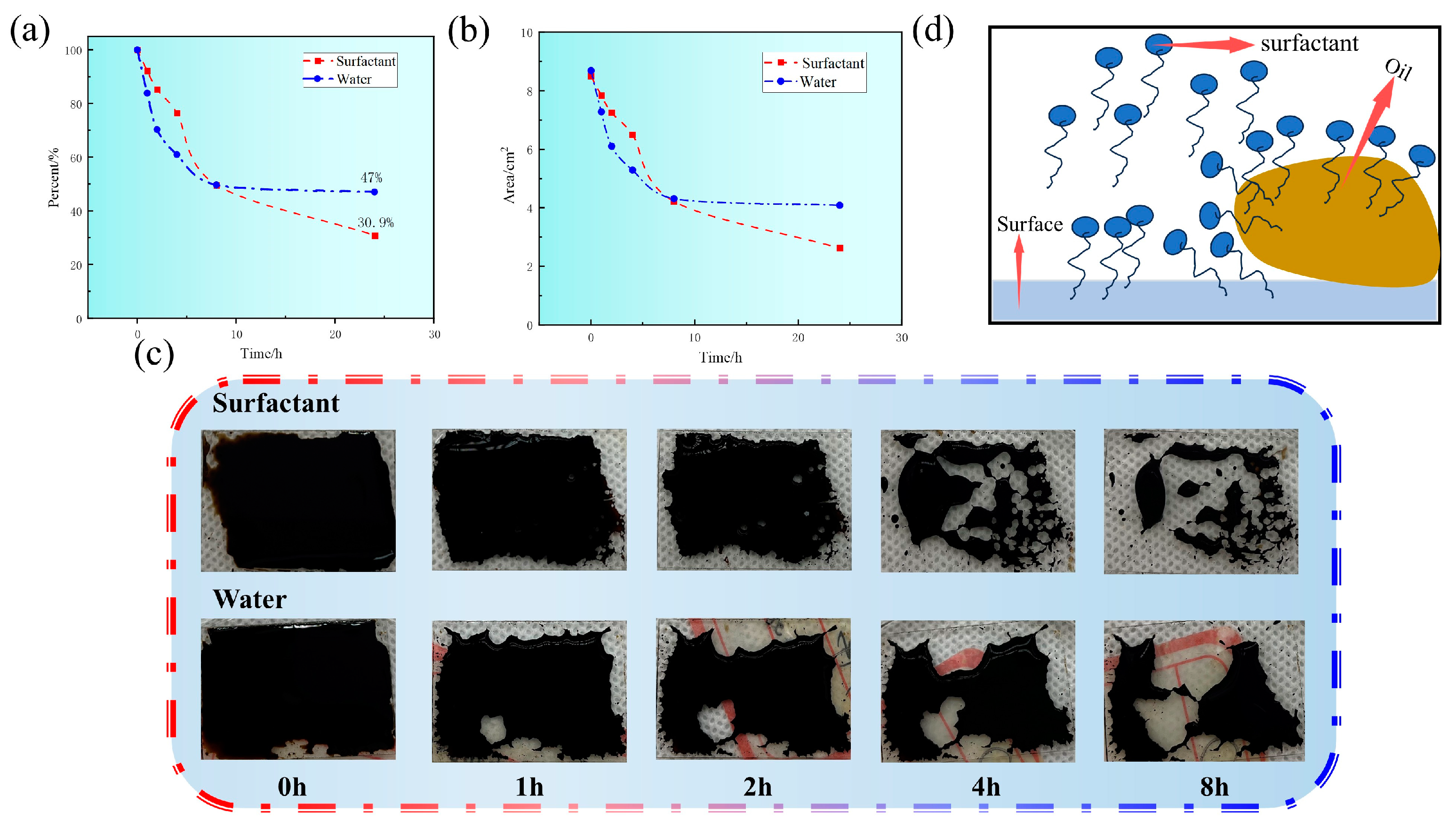
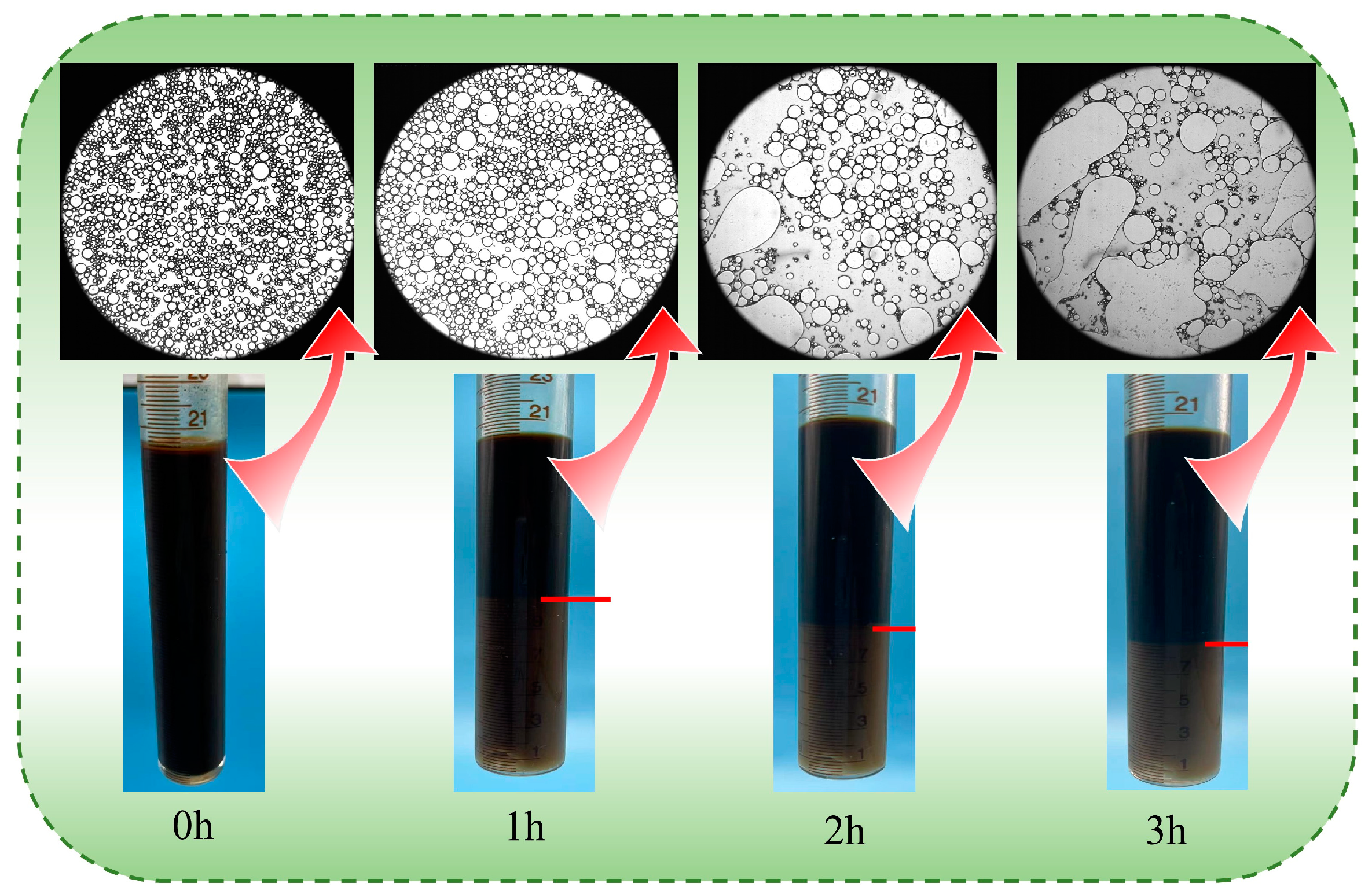
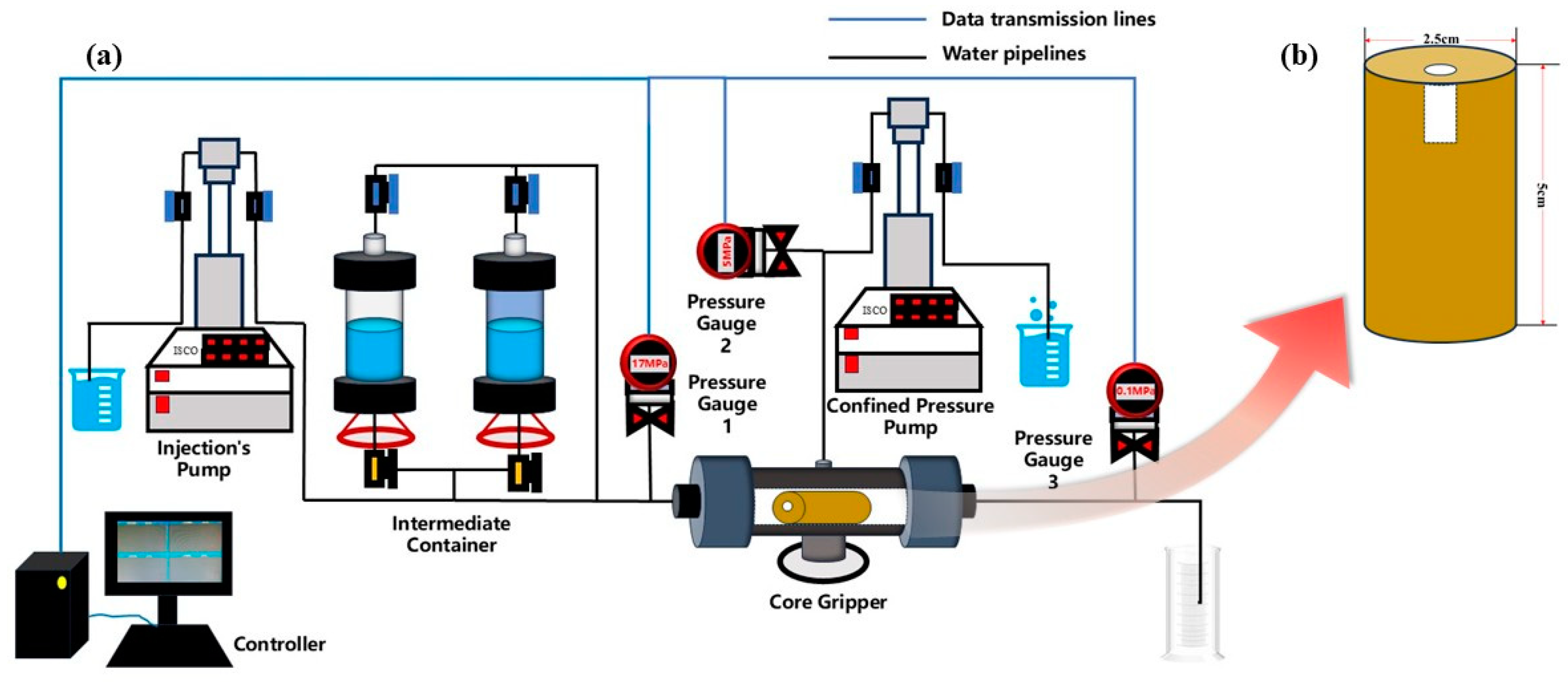
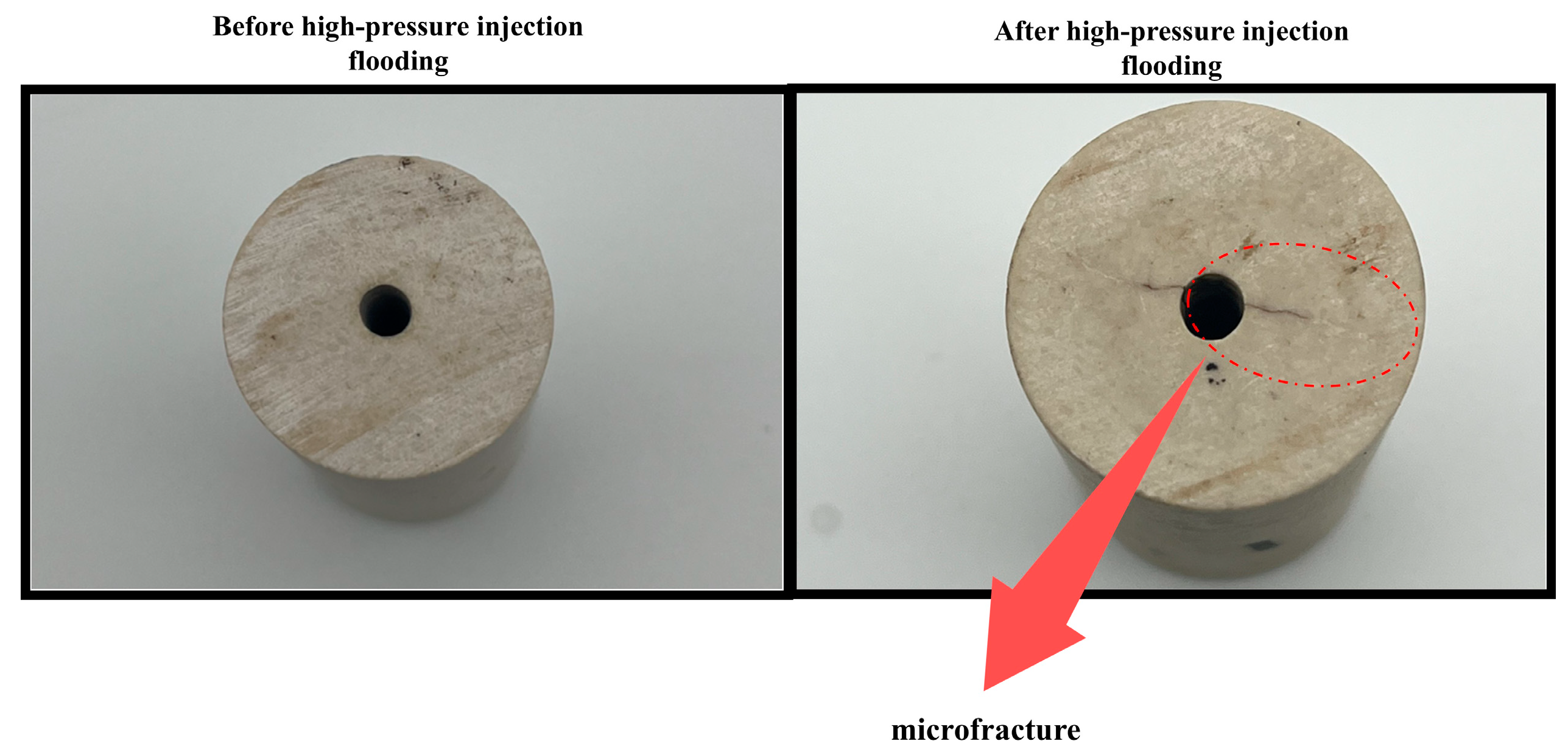

Disclaimer/Publisher’s Note: The statements, opinions and data contained in all publications are solely those of the individual author(s) and contributor(s) and not of MDPI and/or the editor(s). MDPI and/or the editor(s) disclaim responsibility for any injury to people or property resulting from any ideas, methods, instructions or products referred to in the content. |
© 2025 by the authors. Licensee MDPI, Basel, Switzerland. This article is an open access article distributed under the terms and conditions of the Creative Commons Attribution (CC BY) license (https://creativecommons.org/licenses/by/4.0/).
Share and Cite
Peng, W.; You, Q.; Liu, X.; Zhou, B.; Ding, X.; Du, Y.; Xiao, L. Enhance Oil Recovery in Fracture-Cave Carbonate Reservoirs Using Zwitterion-Anionic Composite Surfactant System. Energies 2025, 18, 383. https://doi.org/10.3390/en18020383
Peng W, You Q, Liu X, Zhou B, Ding X, Du Y, Xiao L. Enhance Oil Recovery in Fracture-Cave Carbonate Reservoirs Using Zwitterion-Anionic Composite Surfactant System. Energies. 2025; 18(2):383. https://doi.org/10.3390/en18020383
Chicago/Turabian StylePeng, Wei, Qing You, Xiaoqiang Liu, Bojie Zhou, Xingxing Ding, Yuechun Du, and Liangfei Xiao. 2025. "Enhance Oil Recovery in Fracture-Cave Carbonate Reservoirs Using Zwitterion-Anionic Composite Surfactant System" Energies 18, no. 2: 383. https://doi.org/10.3390/en18020383
APA StylePeng, W., You, Q., Liu, X., Zhou, B., Ding, X., Du, Y., & Xiao, L. (2025). Enhance Oil Recovery in Fracture-Cave Carbonate Reservoirs Using Zwitterion-Anionic Composite Surfactant System. Energies, 18(2), 383. https://doi.org/10.3390/en18020383






